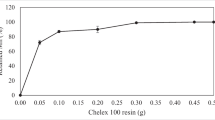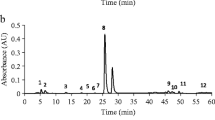Abstract
The total and soluble contents of three potentially toxic elements (PTEs) (Cd, Cr, and Pb) and two essential elements (Cu and Ni) in commercial green and roasted mate (Ilex paraguariensis St. Hil.) and their hot infusions were accessed by inductively coupled plasma mass spectrometry. Total polyphenolic (TP) contents in the infusions were accessed by Folin-Ciocalteu method, and the presence of soluble melanoidins (SM) was evaluated by measuring absorbances at 420 nm. The soluble element contents in hot infusions of green mate were present in the following increasing order: Pb < Cd < Cr < Cu, and Ni. For hot infusions of roasted mate, the increasing order was: Cu < Pb < Cd < Cr < Ni. Except for Cr, hot infusions of roasted mate supply lower contents of the soluble PTEs than hot infusions of green mate. Cadmium was the only of evaluated trace element found in hot infusions of green and roasted mate as well as in some of their mate samples above the maximum allowed contents established by Brazilian legislation. Despite this, polyphenol and melanoidin contents in green and roasted mate infusions may reduce Cd bioavailability. The soluble trace elements that correlated directly with total polyphenols in hot infusions of green or roasted mate are indirectly correlated with the presence of soluble melanoidins. Moreover, this is the first study to evaluate the correlations of soluble forms of Cd, Cr, Cu, Ni, and Pb with the presence of SM and TP contents in hot infusions of green and roasted mate.
Similar content being viewed by others
Data Availability
All data generated or analyzed during this study are included in this published article and its supplementary information file.
References
Marcelo MCA, Martins CA, Pozebon D, Dressler VL, Ferrão MF (2014) Classification of mate (Ilex paraguariensis) according to the country of origin based on element concentrations. Microchem J 11:164–171. https://doi.org/10.1016/j.microc.2014.06.027
FAO (2019) Food and Agriculture Organization of the United Nations. https://www.fao.org/faostat/en/#data. Accessed 27 October 2021
Pozebon D, Dressler VL, Marcelo MCA, Oliveira TC, Ferrão MF (2015) Toxic and nutrient elements in mate (Ilex paraguariensis). Food Addit Contam Part B Surveill 8:215–220. https://doi.org/10.1080/19393210.2015.1053420
Riachi LG, Simas DLR, Coelho GC, Marcellini PS, Silva AJR, Maria CAB (2018) Effect of light intensity and processing conditions on bioactive compounds in maté extracted from mate (Ilex paraguariensis A. St.-Hil). Food Chem 266:317–322. https://doi.org/10.1016/j.foodchem.2018.06.028
Croge CP, Cuquel FL, Pintro PTM (2021) Mate: cultivation systems, processing and chemical composition. Rev Sci Agric 78:1–11. https://doi.org/10.1590/1678-992X-2019-0259
Holowaty SA, Thea AE, Alegre C, Schmalko ME (2018) Differences in physicochemical properties of mate (Ilex paraguariensis) obtained using traditional and alternative manufacturing methods. J Food Process Eng 41:1–10. https://doi.org/10.1111/jfpe.12911
Gambero A, Ribeiro ML (2015) The positive effect of mate (Ilex paraguariensis) in obesity. Nutrients 7:730–750. https://doi.org/10.3390/nu7020730
Cardozo Junior EL, Morand C (2016) Interest of mate (Ilex paraguariensis A.-St. Hil.) as a new natural functional food to preserve human cardiovascular health – a review. J Funct Foods 21:440–454. https://doi.org/10.1016/j.jff.2015.12.010
Burris KP, Harte FM, Davidson PM, Stewart CN Jr, Zivanovic S (2012) Composition and bioactive properties of Mate (Ilex paraguariensis A.St.-Hil.): a review. Chil J Agric Res 72:268–275. https://doi.org/10.4067/s0718-58392012000200016
Da Costa AMG, Nogamy EM, Visentainer JV, De Souza NE, Garcia EE (2009) Fractionation of aluminum in commercial green and roasted mate samples (Ilex paraguariensis St. Hil.) and in their infusions. J Agric Food Chem 57:196–200. https://doi.org/10.1021/jf802808h
Gómez-Juaristi M, Martínez-López S, Sarria B, Bravo L, Mateos R (2018) Absorption and metabolism of mate phenolic compounds in humans. Food Chem 240:1028–1038. https://doi.org/10.1016/j.foodchem.2017.08.003
Dawidowicz AL, Typek R (2017) Transformation of chlorogenic acids during the coffee beans roasting process. Eur Food Res Technol 243:379–390. https://doi.org/10.1007/s00217-016-2751-8
Da Silveira TFF, Meinhart AD, Souza TCL, Teixeira Filho J, Godoy HT (2016) Phenolic compounds from mate based beverages – a multivariate optimisation. Food Chem 190:1159–1167. https://doi.org/10.1016/j.foodchem.2015.06.031
Adams A, Borrelli RC, Fogliano V, De Kimpe N (2005) Thermal degradation studies of food melanoidins. J Agric Food Chem 53:4136–4142. https://doi.org/10.1021/jf047903m
De Campos BK, Dos Prazeres JP, Torres YR, Dos Anjos VE, Quináia SP (2014) Avaliação da labilidade de alumínio em infusões de erva-mate empregando voltametria. Quim Nova 37:1479–1486. https://doi.org/10.5935/0100-4042.20140226
Rusinek-Prystupa E, Marzek Z, Sembratowicz I, Samolińska W, Kiczorowska B, Kwiecień M (2016) Content of select minerals and active ingredients in teas containing mate and rooibos. Biol Trace Elem Res 172:266–275. https://doi.org/10.1007/s12011-015-0588-9
Migo VP, del Rosario EJ, Matsumura M (1997) Floculation of melanoidins induced by inorganic ions. J Ferment Bioeng 83:287–291. https://doi.org/10.1016/S0922-338X(97)80994-4
Pohl P, Stelmach E, Szymczycha-Madeja A (2014) Determination of total concentration and chemical and physical fractionation forms of manganese in infusions of ground coffee. Food Anal Methods 7:676–682. https://doi.org/10.1007/s12161-013-9674-9
Moreira ASP, Nunes FM, Domingues MR, Coimbra MA (2012) Coffee melanoidins: structures, mechanisms of formation and potential health impacts - review. Food Funct 3:903
Voica C, Nechita C, Iordache AM, Robac C, Zgavarogea R, Ionete RE (2021) ICP-MS assessment of essential and toxic trace elements in foodstuffs with different geographic origins available in Romanian supermarkets. Molecules 26:7081. https://doi.org/10.3390/molecules26237081
Pipoyan D, Hovhannisyan A, Beglaryan M, Mantovani A (2022) Risk assessment of potentially toxic trace elements via consumption of dairy products sold in the city of Yerevan. Armenia Food Chem Toxicol 163:112922. https://doi.org/10.1016/j.fct.2022.112922
Magri E, Valduga AT, Gonçalvez IL, Barbosa JZ, Rabel DO, Menezes IMNR, Nascimento PA, Oliveira A, Corrêa RS, Motta ACV (2021) Cadmium and lead concentrations in mate leaves from agroforestry and plantation systems: an international survey in South America. J Food Compos Anal 96:1–10. https://doi.org/10.1016/j.jfca.2020.103702
Proch J, Orłowska A, Niedzielski P (2021) Elemental and speciation analyses of different brands of yerba mate (Ilex paraguariensis). Foods 10:2925. https://doi.org/10.3390/foods10122925
Jaishankar M, Tseten T, Anbalagan N, Mathew BB, Beeregowda KN (2014) Toxicity, mechanism and health effects of some heavy metals. Interdiscip Toxicol 7:60–72. https://doi.org/10.2478%2Fintox-2014-0009
Guerra F, Trevizam AR, Muraoka T, Marcante NC, Canniatti-Brazaca SG (2012) Heavy metals in vegetables and potential risk for human health. Sci Agric 69:54–60. https://doi.org/10.1590/S0103-90162012000100008
Milani RF, Silvestre LK, Morgano MA, Cadore S (2019) Investigation of twelve trace elements in herbal tea commercialized in Brazil. J Trace Elem Med Biol 52:111–117. https://doi.org/10.1016/j.jtemb.2018.12.004
Zhang J, Yang R, Chen R, Peng Y, Wen X, Gao L (2018) Accumulation of heavy metals in tea leaves and potential health risk assessment: a case study from Puan County, Ghizhou Province, China. Int J Environ Res Public Health 15:1–22. https://doi.org/10.3390/ijerph15010133
Lv H-P, Lin Z, Tan J-F, Guo L (2013) Contents of fluoride, lead, copper, chromium, arsenic and cadmium in Chinese Pu-erh tea. Food Res Int 53:938–944. https://doi.org/10.1016/j.foodres.2012.06.014
Karak T, Bhagat RM (2010) Trace elements in tea leaves, mate tea and tea infusion: a review. Food Res Int 43:2234–2252. https://doi.org/10.1016/j.foodres.2010.08.010
IUPAC (2014) Compendium of chemical terminology – Gold Book. http://goldbook.iupac.org/files/pdf/goldbook.pdf. Accessed 16 February 2022
Long GL, Winefordner JD (1983) Limit of detection – a closer look at the IUPAC definition. Anal Chem 55:712A-724A
Singleton VL, Rossi JA (1965) Colorimetry of total phenolics with phosphomolybdic-phosphotungstic acid reagents. Am J Enol Vitic 16:144–158
Šilarová P, Česlová L, Meloun M (2017) Fast gradient HPLC/MS separation of phenolics in green tea to monitor their degradation. Food Chem 237:471–480. https://doi.org/10.1016/j.foodchem.2017.05.133
Morales FJ, Fernández-Fraguas C, Jiménez-Pérez S (2005) Iron-binding ability of melanoidins from food and model systems. Food Chem 90:821–827. https://doi.org/10.1016/j.foodchem.2004.05.030
Novotnik B, Zuliani T, Scancar J, Milaci R (2015) Content of trace elements and chromium speciation in Neem powder and tea infusions. J Trace Elem Med Biol 31:98–106. https://doi.org/10.1016/j.jtemb.2015.04.003
Chen S, Zhu S, He Y, Lu D (2014) Speciation of chromium and its distribution in tea leaves and tea infusion using titanium dioxide nanotubes packed microcolumn coupled with inductively coupled plasma mass spectrometry. Food Chem 150:254–259. https://doi.org/10.1016/j.foodchem.2013.10.150
Caroli S Problems of speciation of elements in natural waters: the case of chromium and selenium. In: Winefordner JD (1996) Element speciation in bioinorganic chemistry, John Wiley and Sons Inc
Bekedam EK (2008) Coffee brew melanoidins – structural and functional properties of brown-colored coffee compounds. Ph.D. thesis, Wageningen University
Inomata Y, Haneda T, Howell FS (1999) Characterization and crystal structures of zinc(II) and cadmium(II) complexes with D(–)-quinic acid. J Inorg Biochem 76:13–17. https://doi.org/10.1016/s0162-0134(99)00101-4
Qi J-L, Zhen Y-Q, Xu W (2015) Three acentric Cu(II) D-(–)-quinate complexes: solvent-dependent assemblies, magnetic and ferroelectric properties. Synth React Inorg, Met-Org, Nano-Met Chem 46:257–267. https://doi.org/10.1080/15533174.2013.865217
Rizzi G (1997) Chemical structure of colored Maillard reaction products. Food Rev Int 13:1–28 https://doi.org/10.1080/87559129709541096
O’Brien J, Morrissey PA (1997) Metal ion complexation by products of Maillard reaction. Food Chem 58:17–27. https://doi.org/10.1016/S0308-8146(96)00162-8
Pohl P, Dzimitrowicz A, Jedryczko D, Szymczycha-Madeja A, Welna M, Jamroz P (2016) The determination of elements in herbal teas and medicinal plant formulations and their tisanes. J Pharm Biomed Anal 130:326–335. https://doi.org/10.1016/j.jpba.2016.01.042
ANVISA (2021) Resolução - RDC nº 487, de 26 de março de 2021, Diário Oficial da União. Dispõe sobre os limites máximos tolerados (LMT) de contaminantes em alimentos, os princípios gerais para o seu estabelecimento e os métodos de análise para fins de avaliação de conformidade
EC (2006) Comission Regulation (EC) n° 1881/2006 of 19 December 2006 setting maximum levels for certain contaminants in foodstuffs. Off J Eur Union 49:5-24
Dennis KK, Judd SE, Alvarez JA, Hake K, Jones DP, Hartman TJ (2021) Plant food intake is associated with lower cadmium body burden in middle-aged adults. Eur J Nutr 60:3365–3374. https://doi.org/10.1007/500394-021-02513-3
Sun S, Zhou X, Li Y, Li Y, Xia H, Li Z, Zhuang P (2020) Use of dietary components to reduce the bioaccessibility and bioavailability of cadmium in rice. J Agric Food Chem 68:4166–4175. https://doi.org/10.1021/acs.jafc.0c01582
Mukaka MM (2012) Statistics Corner: a guide to appropriate use of correlation coefficient in medical research. Malawi Med J 24:69–71
AOAC (2016) Guidelines for standard method performance requirements. AOAC Official Methods of Analysis
Acknowledgements
The authors are also very grateful to Prof. Dr. Joaquim A. Nóbrega and Dr. Lucimar L. Fialho from the Group of Applied Instrumental Analysis—GAIA (Federal University of São Carlos) for their important contributions to this study.
Funding
The authors received partial financial support from the Coordination for the Improvement of Higher Education Personnel (CAPES) under the Ministry of Education of Brazil and the National Council for Scientific and Technological Development (CNPq) under the Ministry of Science and Technology of Brazil (308178/2018–1).
Author information
Authors and Affiliations
Corresponding author
Ethics declarations
Competing Interests
The authors declare no competing interests.
Additional information
Publisher's Note
Springer Nature remains neutral with regard to jurisdictional claims in published maps and institutional affiliations.
Supplementary Information
Below is the link to the electronic supplementary material.
Rights and permissions
About this article
Cite this article
Ribeiro, S.A.O., da Silva, C.S., de Araújo Nogueira, A.R. et al. Solubility of Cd, Cr, Cu, Ni, and Pb and Its Correlation with Total Polyphenols and Soluble Melanoidins in Hot Infusions of Green and Roasted Mate. Biol Trace Elem Res 201, 2563–2572 (2023). https://doi.org/10.1007/s12011-022-03314-3
Received:
Accepted:
Published:
Issue Date:
DOI: https://doi.org/10.1007/s12011-022-03314-3




